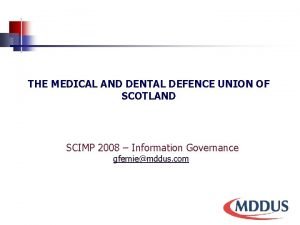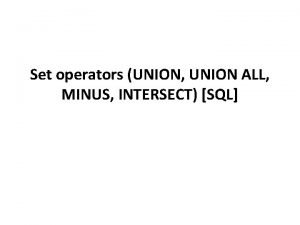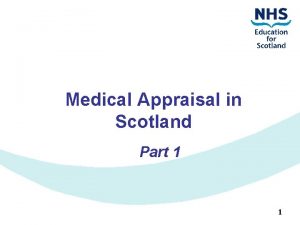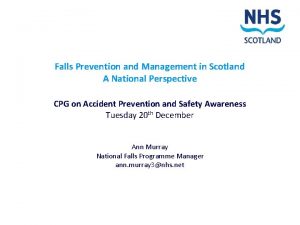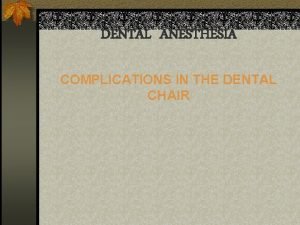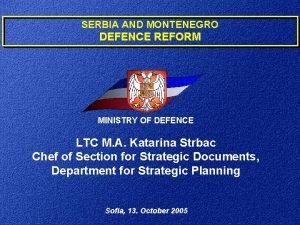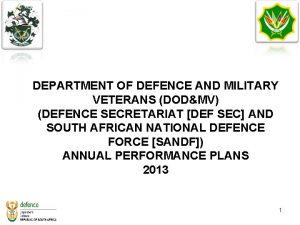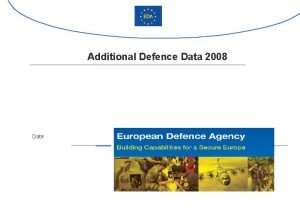THE MEDICAL AND DENTAL DEFENCE UNION OF SCOTLAND























- Slides: 23

THE MEDICAL AND DENTAL DEFENCE UNION OF SCOTLAND SCIMP 2008 – Information Governance gfernie@mddus. com

CLINICAL GOVERNANCE Clinical governance is the system through which NHS organisations are accountable for continuously improving the quality of their services and safeguarding high standards of care, by creating an environment in which clinical excellence will flourish

INFORMATION GOVERNANCE Information Governance ensures necessary safeguards for, and appropriate use of, patient and personal information. Key areas are information policy for health and social care, IG standards for National Programme for IT systems and development of guidance for NHS and partner organisations.

TELEPHONE ADVICE






DEFAMATION STATEMENT In general, a defamatory statement is one which – “Tends to lower an individual’s reputation in the eyes of right thinking members of society, or which would cause him to be shunned or bring him into hatred, ridicule or contempt, or which tends to discredit him in his profession or trade. ”

DEFAMATION STATEMENT There a number of defences to a claim of defamation these include: - (a) justification - being able to show that was said is true; (b) fair comment on a matter of public interest - the honest expression of opinion; and (c) privilege - a statement fairly made in the discharge of a public or private duty.

VEXATIOUS REQUEST Case Ref: FS 50170245 Date: 09/08/2007 Public Authority: Dr Tessa Buckman Summary: The complainant submitted a request to a GP (who, for the purposes of the Act is considered to be a public authority in her own right). The GP refused to answer this request on the basis that it was vexatious. Having considered the evidence in this case, the Commissioner is satisfied that the request was vexatious because, when taken in the context of the complainant’s previous correspondence and other actions, this request imposed a significant burden on the GP and also had the effect of harassing her. This decision notice is currently under appeal to the Information Tribunal. Section of Act/EIR & Finding: FOI 14 - Complaint Not upheld

USE OF VIOLENT WARNING MARKERS This guidance explains to those working with the public how best to manage the use of violent warning markers Employers have a duty of care to their staff to protect them in the workplace. Violent warning markers are a means of identifying and recording individuals who pose, or could possibly pose, a risk to the members of staff who come into contact with them. We understand that, in practice, a flagged piece of text is attached to an individual's file.

USE OF VIOLENT WARNING MARKERS Processing must be fair and lawful. This means that a decision to put a marker on an individual's file must be based on a specific incident or expression of clearly identifiable concern by a professional, rather than general opinions about that individual. For consistency, you should make sure a senior nominated person in the organisation is responsible for making these decisions. Decisions should be reviewed regularly. When making a decision this person should take into account: • the nature of the threat; • the degree of violence used or threatened; and • whether or not the incident indicates a credible risk of violence to staff.


DATA PROTECTION ACT 1998 EXCLUSIONS Section 29 of the DPA 1998 provides that information can be disclosed without gaining an individual’s consent where failure to gain the information would be likely to prejudice: • the prevention or detection of crime • the apprehension or prosecution of offenders • the collection or assessment of any tax or duty

DATA PROTECTION ACT 1998 EXCLUSIONS The conditions for sharing of ‘personal information’ most likely to apply to NHS is when it is necessary a) for the administration of justice b) for the exercise of any functions conferred on any person by or under any enactment c) for the exercise of any functions of the Crown, a Minister of the Crown, or government department or d) for the exercise of any other functions of a public nature exercised in the public interest by any person.

Case 1 The police have telephoned this morning requesting information on one of your patients. The patient has been registered as missing. Can you disclose anything? § § Patient confidentiality – may not wish to be found Obtain more information from police – suspicious circumstances which may compel disclosure Consideration of clinical conditions or prescribing records to assess risk to self or others Justification


Case 2 Pharmaceutical company offer to provide nurse to audit PPI usage and modify treatment regime § § § No explicit consent Company wrote introductory letter to patients One patient had been removed from List Complaint to Information Commissioner Reported case to PF No-Pro

Case 3 Patient sitting in waiting room when name is called out over Tannoy. Adjacent patient goes into consulting room ahead of him. When he exits, the correct patient goes in to see GP and expresses concern there has been a breach of confidentiality. n n n What was visible on screen? Incorrect data entry Audit trail Possible supplementary breach (IGTN) Apology & Correction

Case 4 Separated parents of 3 year old boy going through acrimonious divorce. Resides with mother who has reverted to maiden name. Letter received from father’s solicitor demanding his surname is used. n n n Does father have parental responsibility? Consistency required to avoid systems failure Court to decide

Case 5 Patient makes legitimate subject access request and discovers practice are aware he is HIV +ve and had been attending the communicable disease clinic in another area. n n n Request that material is deleted Factually accurate Clinically relevant Practice Meeting Remedy in terms of s. 14 DPA Reminded of ECS opt-out
 Medical defence union of scotland
Medical defence union of scotland Intersect and minus in sql
Intersect and minus in sql Medical appraisal scotland
Medical appraisal scotland England and scotland both produce scones and sweaters
England and scotland both produce scones and sweaters Difference between medical report and medical certificate
Difference between medical report and medical certificate Nanosystems in security and defence
Nanosystems in security and defence Defence centre for languages and culture
Defence centre for languages and culture Aerospace and defense industries association of europe
Aerospace and defense industries association of europe Aerospace and defense industries association of europe
Aerospace and defense industries association of europe Steve grzeskowiak
Steve grzeskowiak Natinamds
Natinamds Dehpd
Dehpd What is a national risk ambulance
What is a national risk ambulance Sssc falls prevention
Sssc falls prevention Northern ireland
Northern ireland Sexual health and relationships education scotland
Sexual health and relationships education scotland Hát kết hợp bộ gõ cơ thể
Hát kết hợp bộ gõ cơ thể Slidetodoc
Slidetodoc Bổ thể
Bổ thể Tỉ lệ cơ thể trẻ em
Tỉ lệ cơ thể trẻ em Voi kéo gỗ như thế nào
Voi kéo gỗ như thế nào Tư thế worm breton là gì
Tư thế worm breton là gì Chúa yêu trần thế
Chúa yêu trần thế Các môn thể thao bắt đầu bằng tiếng nhảy
Các môn thể thao bắt đầu bằng tiếng nhảy
